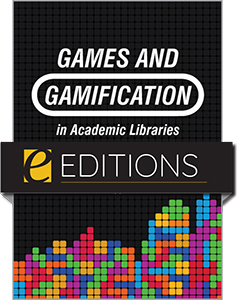
Games and Gamification in Academic Libraries—eEditions PDF e-book
The download link for this product can be found on the final confirmation screen after you complete your purchase, and may also be accessed from your Account Profile. For more information about ALA eEditions file types and how to view them on eReaders, desktop computers, and other devices, see this page.
Primary tabs
You don't need to be an ALA Member to purchase from the ALA Store, but you'll be asked to create an online account/profile during checkout to proceed. This Web Account is for both Members and non-Members. Note that your ALA Member discount will be applied at the final step of the checkout process.
If you are Tax-Exempt, please verify that your account is currently set up as exempt before placing your order, as our new fulfillment center will need current documentation. Learn how to verify here.
- Description
- Table of Contents
- About the authors
Games of all kinds, from breakouts and escape rooms to traditional board game collections, are often featured in academic library instruction, programming, and outreach initiatives, where their natural ability to foster interaction and communication is especially valuable. Games and gamification can be used to help students engage with the thresholds of the ACRL Framework for Information Literacy for Higher Education; locate resources and identify misinformation and disinformation; and build connections with faculty and librarians, in one-shots and for-credit courses.
In four sections—An Overview of Games and Gamification, Adding and Maintaining a Circulating Game Collection to your Library, Games and Gamification in Information Literacy Instruction, and Programming and Outreach through Games—Games and Gamification in Academic Libraries explores incorporating games into first-year experience programs, using games to help students engage with special collections, making games accessible, and ideas for game nights and events. The book is packed with full-color figures, photos, and samples for inspiration and easy repurposing.
Games and gamification function best not as something separate, but as one tool in an academic library’s approach to their goals and initiatives. Games and Gamification in Academic Libraries offers encouragement, strategies, and proven practices for developing and using accessible, welcoming gamification as a flexible tool to meet their institutions’ missions and their students’ learning needs.
Introduction
Stephanie Crowe and Eva Sclippa
SECTION I. An Overview of Games and Gamification
Chapter 1. The Gaming Program at Oxford College Library
Courtney Baron
Chapter 2. Here You Can Play: Fostering Creativity in an Academic Library
Tammi M. Owens and Claire Staub
Chapter 3. Adding “Flair” and Escaping the Usual: Gamifying Training
Mackenzie Morning
Chapter 4. Level Up! Making Games Accessible
Angie Brunk and Dale Monobe
SECTION II. Adding and Maintaining a Circulating Game Collection in Your Library
Chapter 5. Taming the Beast: Game Collection Management in an Academic Library
Diane Robson and Erin DeWitt-Miller
Chapter 6. Instructional Gaming Levels Up!
Stephen “Mike” Kiel
Chapter 7. Lessons Learned from Circulating a Tabletop Game Collection at a Small, Academic Library
Emily Moran
SECTION III. Games and Gamification in Information Literacy Instruction
Chapter 8. Play’s the Thing: Using Games to Create Authentic Learning Experiences in the One-Shot Workshop
Christina E. Dent and Cate Schneiderman
Chapter 9. Trial By Fire: Gaming and Badging in an FYE Program
Wendy Girven Pothier, Kathrine C. Aydelott, and Benjamin Peck
Chapter 10. Saving the World with Information Literacy: Playing with Information in a For-Credit Class
Stephanie Crowe and John Osinski
Chapter 11. Breaking Out of the Ordinary: Using BreakoutEDU and Escape Rooms in the Academic Library
Lara Fountaine
Chapter 12. Make Your Escape: Experiences with Gamified Library Programming
Tim Miller, Kimberly Stelter, Garrett Purchio, and Brianne Hagen
SECTION IV. Programming and Outreach through Games
Chapter 13. So Overt It’s Covert: Learning via Games in the Library
Kimberly Vardeman, Ian Barba, Shelley Barba, and Heidi Winkler
Chapter 14. Where Do We Go from Here? Expanding the Reach of Your Gaming Events
Teresa Slobuski, Eric Johnson, Ginny Boehme, and Lauren Hays
Chapter 15. Out of the Class and Onto the Board: Building Student-Faculty Relationships and Easing Library Anxiety through Board Game Nights
Stephanie Diaz and Russell Hall
Chapter 16. Dewey Decimated!: Creating an Immersive Escape Room from Beginning to End
Eva Sclippa, Rebecca Baugnon, Stephanie Crowe, Jason Fleming, and Peter Fritzler
Chapter 17. Old Building, New Experience: Gamifying Special Collections Orientation
Emily Jack
About the Authors
Stephanie Crowe
Stephanie Crowe is the coordinator of liaison librarian services at the University of North Carolina Wilmington. She previously worked as the social sciences librarian at UNCW, as a research specialist for the Center for Biology and Society at Arizona State University and as the archivist for the Charles Babbage Institute at the University of Minnesota. She holds an MSLS from the University of North Carolina-Chapel Hill and an MA in public history from North Carolina State University.
Eva Sclippa
Eva Sclippa is the first-year engagement librarian at the University of North Carolina Wilmington, where she works to build connections between first-year students and the library through outreach, programming, and information literacy instruction. She holds a BA and MA in art history in addition to her MLS from UNC Chapel Hill, and her research interests range from gamification to medieval manuscript illumination. Her personal interests include knowing and enthusiastically sharing an uncomfortable amount of information about historical epidemics, cryptid folklore, and the occult.


